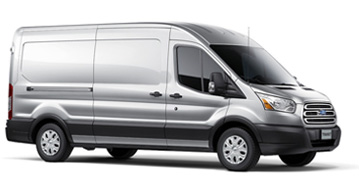Advanced Clean Diesel
In this section
- Advanced Clean Diesel
- HEVs
- BEVs
- PHEVs
- Renewable Biofueled Vehicles
- CNG/LPG Vehicles
- FCVs

Advanced Clean Diesel
Ford’s New Full-Size Transit Van
Modern diesels are 30 to 40 percent more fuel efficient than gasoline vehicles. Ford offers a range of advanced diesels in Europe under the ECOnetic label. In the U.S., Ford introduced a new 3.2L Power Stroke® turbo diesel engine in our full-size Transit van, following up on the launch of a new 6.7L V8 Power Stroke turbo diesel in the 2011 F-Series Super Duty® truck, which had 20 percent better fuel economy than the outgoing model.
Technology Overview and Benefits
Diesel engine technology is not in itself new. However, advanced diesel technologies offer significant advantages over traditional gasoline engines and older diesel engines. They consume 30 to 40 percent less fuel than gasoline engines, and on a well-to-wheels basis they emit 15 to 30 percent less carbon dioxide (CO2).1 In addition, direct-injection diesel engines provide exceptional power and torque, resulting in better driving performance and towing capabilities. Advanced diesel technology also dramatically reduces non-CO2 tailpipe emissions such as NOx and particulate matter.
Our advanced diesel engines use a range of technologies in the engine and after-treatment systems to reduce emissions. For example:
Our 1.6L Duratorq® TDCi engine, used on European vehicles, includes more efficient eight-hole fuel-injector nozzles, a more powerful engine-control unit and a water-cooled charge air cooler. In addition, parasitic losses have been cut through use of low-friction piston ring coatings, a variable-flow oil pump and a more-efficient vacuum pump. After-treatment system improvements include a coated diesel particulate (soot) filter coupled with a lean NOx trap to enable Euro 5 emissions compliance.
Our 6.7L Power Stroke V8 diesel, offered on Super Duty Trucks in the U.S., which has 20 percent better fuel economy and 14 percent more power than the previous model, uses an innovative exhaust gas recirculation system with two independent cooling loops, which enable optimal combustion phasing for fuel economy while reducing NOx emissions from the engine into the after-treatment system. It also uses a high-precision, common-rail fuel-injection system featuring piezo-electric injectors. This system uses a stack of more than 300 wafer-thin ceramic platelets to control the fuel-injector nozzle, allowing it to operate faster than other electro-mechanical fuel injectors, decrease fuel consumption and reduce emissions.
Our diesel engines offered in the U.S also use a range of advanced after-treatment technologies to reduce emissions, including:
- a diesel oxidation catalyst that converts and oxidizes hydrocarbons into water and carbon dioxide;
- selective catalytic reduction that uses an ammonia and water solution to convert the NOx in the exhaust stream into water and inert nitrogen; and
- a diesel particulate filter that traps any remaining soot and periodically burns it away when sensors detect that the trap is full.
Deployment
In Europe, where diesel-powered vehicles account for more than 50 percent of new vehicle sales and make up approximately 30 percent of the total vehicle fleet on the road, Ford continues to improve its strong lineup of fuel-efficient and clean diesel vehicles. For example, we continue to introduce ECOnetic versions of Ford models that deliver improved fuel economy and emissions. The ECOnetic lineup currently includes versions of the Ford Fiesta, Focus, Mondeo and Transit. Several of the ECOnetic models use diesel engines, which meet the stringent Euro 5 emissions standards and emit less than 100 g/km of CO2. For example, the new Focus ECOnetic has fuel economy of 3.4L/100km and emits just 89 g/km of CO2.
In North America, where diesels engines are primarily used in the medium-duty truck market, Ford offers two advanced diesel engines. In 2012, we introduced a diesel version of the full-size Transit van, powered by a new 3.2L Power Stroke turbo diesel engine. Like the larger 6.7L Power Stroke V8 diesel, which Ford introduced on F-Series Super Duty trucks in 2011, the 3.2L turbo diesel engine’s fuel system has been carefully tailored and calibrated for combustion efficiency. It enables the newest Power Stroke engine to achieve exceptional fuel-economy ratings without affecting power levels.
These new diesel engines also meet the U.S. Environmental Protection Agency’s and California Air Resources Board’s strict 2010 heavy-duty truck emission regulations, which require 80 percent lower NOx emissions than the 2007 regulations.
Our advanced diesel engines are also compatible with biodiesel, a renewable fuel made from soybean oil and other fats. The 2011 Super Duty is Ford’s first vehicle in North America that is B20 compatible, meaning it can run on fuel composed of 20 percent biodiesel and 80 percent ultra-low-sulfur diesel. The diesel Transit van is also expected to be B20 compatible. In Europe, our vehicles are compatible with B7, and we are working with European fuel standards organizations to establish fuel-quality standards for biodiesel blends greater than B5. The use of biodiesel helps to reduce dependence on foreign oil and reduces lifecycle CO2 emissions. For more information on biofuels, please see the Renewable Biofueled Vehicles section.
- Figures based on J.L. Sullivan, R.E. Baker, B.A. Boyer, R.H. Hammerle, T.E. Kenney, L. Muniz, and T.J. Wallington, 2004, “CO2 Emission Benefit of Diesel (versus Gasoline) Powered Vehicles,” Environmental Science and Technology, 38: 3217-3223.










